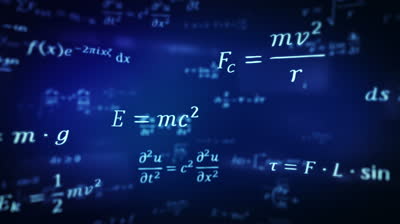Section 1: Mechanics
1. The skydiver
Consider a skydiver falling out of an airplane. Approximate the external force on the skydiver, given that air resistance is proportional to the velocity squared .
Part 1: Use the force equation to calculate the terminal velocity .
Part 2: Change your equation from Part 1 into a first-order differential equation. Then use your result to arrive at the integral
- .
Part 3: Solve the above integral. Then rearrange the velocity solution as a function of time.
2. The spinning bucket
Consider a bucket of water rotated at the z-axis as pictured below. Suppose the water rotates around the z-axis at some rotation rate . Show that the depression of the water surface is a parabola. Find the potential energy of the effective force.
3. Mechanics of the Coulomb potential
Consider the problem of firing a proton at a nucleus of atomic number (so that one views the nucleus as immobile and the origin of the coordinate system, only the proton moves). Work in spherical polar coordinates.
Part 1: Write the Lagrangian for the interaction, using your knowledge of the electrostatic forces.
Part 2: Determine the Euler-Lagrange equations of motion of the proton. What is the conserved quantity?
4. The continuity equation
The flow rate in an arbitrary volume is given by
where
- .
Use these equations to derive the continuity equation for fluid transport
- .
Section 2: Electromagnetism
1. Gauss’ law for magnetism
First show that for a vector field. The magnetic field is the curl of the vector potential . Use this vector property to derive Gauss’ law for magnetism .
2. Maxwell’s extension
Figure out why is not the complete picture, and derive the Ampere-Maxwell law for time-varying EM fields
- .
3. EM cycloid motion
Consider a charged particle subjected to the initial conditions
- .
Determine the trajectory if the charged particle is released from the origin. This is actually a 2-D problem, but the cross products work in 3-D; hence, the x-components are set to zero.
4. Energy transport of EM fields
Starting with
and the energy density transport
- ,
derive Poynting’s theorem in the form
- .
Section 3: Thermal physics
1. Adiabatic expansion
Derive the formula for an adiabatic expansion of ideal gas , where is a constant. Start from the first law of thermodynamics , the ideal gas law , and the relation .
2. Boxes of ideal gas
Consider two boxes of volume each holding atoms of ideal gas. Both boxes are initially isolated from each other and the surroundings. Box 1 and box 2 have initial temperatures and respectively. The boxes are then brought into thermal contact.
a) Calculate the equilibrium temperature of the two boxes.
b) Calculate the entropy change using the Sackur-Tetrode equation and explain why .
3. Statistical physics of protein folding
For a simple lattice model of protein folding, the residues are connected in links. Consider a four-residue protein model. The open configurations cost no energy, and the folded configurations reduces the energy by .
Part 1: If there are 36 configurations in total, where 8 configurations are folded, calculate the partition function. Then write expressions for the probability when the protein is open and when the protein is folded.
Part 2: What is the probability of the protein being in the folded state when the temperature is large?
Part 3: Calculate the average energy of the protein.
4. Derivation of the heat equation
In thermalhydraulics, energy conservation is encapsulated in the vector field differential form
- .
Let the energy density be , where the specific heat is constant. The conductive heat transfer follows Fourier’s law , where is constant. Derive the heat equation
- .
Hint: you will need to use the conservation of mass
- .
Section 4: Special relativity
1. Relativistic momentum-energy relation
Begin with the relativistic momentum and energy:
Derive the relativistic energy-momentum relation:
2. Lorentz transformation matrix
Given the Lorentz transformation in one direction
expressed the above set of equations as a 2x2 matrix. Calculate the determinant and find the inverse matrix.
3. Muon decay
What is the minimum energy needed for a muon, generated by interactions of cosmic rays with the upper atmosphere, to reach sea level? The thickness of the atmosphere is roughly 10 km. The lifetime in the muon’s rest frame is 2.2 μs. The rest mass of a muon is 105.658 MeV/c2.
4. Relativistic Doppler effect
Begin with the wavelength and frequency of the source to derive the relativistic Doppler effect for the frequency measured by the observer of an approaching source
- .
Note that .
Section 5: Quantum mechanics
1. Ehrenfest theorem and the Commutator
Consider this important identity d〈A ̂ 〉/dt=i/ℏ 〈[H ̂,A ̂ ]〉+〈(∂A ̂)/∂t〉. Prove the Ehrenfest theorem d〈p ̂ 〉/dt=-〈(∂V ̂)/∂x〉.
2. Step potential
A beam of particles with kinetic energy E coming from the left encounters a step barrier described by V(x)={█(0,&x<0@V,&x≥0)┤ Find the probability of transmission and reflection if E>V.
3. Hydrogen-like atom
Verify that the n=1,l=0,m=0 one-electron wavefunction ϕ_100 (r)=Ae^(-Zr/a_B ) satisfies the Schrodinger equation in spherical polar coordinates with a Coulomb potential [-ℏ^2/2m 1/r^2 d/dr (r^2 d/dr)-(Ze^2)/(4πϵ_0 r) ]ψ=Eψ. Note that the Bohr radius is defined a_B=(4πϵ_0 ℏ^2)/(m_e e^2 ) where m_e is the rest mass of an electron. Then calculate the normalization constant A.
4. Eigenstates of a Hamiltonian
Consider a system with two linearly independent states |├ 1⟩┤=(1¦0) and |├ 2⟩┤=(0¦1) . The system is described by the Hamiltonian H=ϵ(■(0&i@-i&0)) where ϵ is a positive real number. a) Find the eigenenergies and the normalized eigenfunctions of H. b) If |├ Ψ(0)⟩┤=|├ 1⟩┤, find |├ Ψ(t)⟩┤ for t>0. c) Consider an observable Q ̂=μ(├|├ 1⟩┤ ⟨├ 1┤|┤-├|├ 2⟩┤ ⟨├ 2┤|┤). Find 〈Q ̂ 〉 as a function of time in the state |├ Ψ(t)⟩┤.
















































